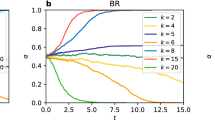Abstract
This paper studies two equilibrium selection methods based on replicator dynamics. A Nash equilibrium is called centroid dominant if the trajectory of the replicator dynamics starting at the centroid of the strategy simplex converges to it. On the other hand, an equilibrium is called basin dominant if it has the largest basin of attraction. These two concepts are compared with risk dominance in the context of \(2 \times 2\) bimatrix coordination games. The main results include (a) if a Nash equilibrium is both risk dominant and centroid dominant, it must have the largest basin of attraction, (b) the basin dominant equilibrium must be risk dominant or centroid dominant.


Similar content being viewed by others
References
Binmore K, Samuelson L (1997) Muddling through: noisy equilibrium selection. J Econ Theory 74:235–265
Borgers T, Sarin R (1997) Learning through reinforcement and replicator dynamics. J Econ Theory 77:1–14
Brown GW (1951) Iterative solution of games by fictitious play. In: Koopmans T (ed) Activity analysis of production and allocation. Wiley, New York
Foster D, Young HP (1990) Stochastic evolutionary game dynamics. Theor Popul Biol 38:219–232
Golman R, Page SE (2010) Basins of attraction and equilibrium selection under different learning rules. J Evol Econ 20:49–72
Harsanyi JC, Selten R (1988) A general theory of equilibrium selection in games. MIT, Cambridge
Hilbe C (2011) Local replicator dynamics: a simple link between deterministic and stochastic models of evolutionary game theory. Bull Math Biol 73:2068–2087
Hofbauer J (1999) The spatially dominant equilibrium of a game. Ann Oper Res 89:233–251
Hofbauer J, Sandholm W (2002) On the global convergence of stochastic fictitious play. Econometrica 70:2265–2294
Hofbauer J, Sigmund K (1998) Evolutionary games and population dynamics. Cambridge University Press, Cambridge
Hofbauer J, Sorger G (1999) Perfect foresight and equilibrium selection in symmetric potential games. J Econ Theory 85:1–23
Hofbauer J, Hutson V, Vickers GT (1997) Travelling waves for games in economics and biology. Nonlinear Anal Theory Methods Appl 30:1235–1244
Kandori M, Mailath GJ, Rob R (1993) Learning, mutation, and long run equilibria in games. Econometrica 61:29–56
Kim Y (1996) Equilibrium selection in \(n\)-person coordination games. Games Econ Behav 15:203–227
Matsui A, Matsuyama K (1995) An approach to equilibrium selection. J Econ Theory 65:415–434
McKelvey RD, Palfrey TA (1995) Quantal response equilibria for normal form games. Games Econ Behav 10:6–38
Morris S, Rob R, Shin HS (1995) \(p\)-dominance and belief potential. Econometrica 63:145–157
Nowak MA, Sigmund K (2004) Evolutionary dynamics of biological games. Science 303:793–799
Samuelson L (1997) Evolutionary games and equilibrium selection. MIT, Cambridge
Schelling TC (1960) The strategy of conflict. Harvard University Press, Cambridge
Schlag K (1998) Why imitate, and if so, how? A boundedly rational approach to multi-armed bandits. J Econ Theory 78:130–156
Taylor P, Jonker L (1978) Evolutionary stable strategies and game dynamics. Math Biosci 50:145–156
Van Huyck JB, Battalio RC, Beil RO (1990) Tacit coordination games, strategic uncertainty, and coordination failure. Am Econ Rev 80:234–248
Weibull J (1995) Evolutionary game theory. MIT, Cambridge
Young HP (1993) The evolution of conventions. Econometrica 61:57–84
Zeeman EC (1980) Population dynamics from game theory. In: Nitecki Z, Robinson C (eds) Global theory of dynamical systems, lecture notes in mathematics, vol 819. Springer, Berlin, pp 471–497
Acknowledgments
We are grateful to Mathias Staudigl and Christian Hilbe for helpful discussions. We also thank the associate editor and two anonymous reviewers for useful comments. This research received financial support from the NSFC (Project No. 11301032) of China, “the Fundamental Research Funds for the Central Universities” of China and the Viennese WWTF (Project No. MA09-017) of Austria.
Author information
Authors and Affiliations
Corresponding author
Rights and permissions
About this article
Cite this article
Zhang, B., Hofbauer, J. Equilibrium selection via replicator dynamics in \(2 \times 2\) coordination games. Int J Game Theory 44, 433–448 (2015). https://doi.org/10.1007/s00182-014-0437-7
Accepted:
Published:
Issue Date:
DOI: https://doi.org/10.1007/s00182-014-0437-7




